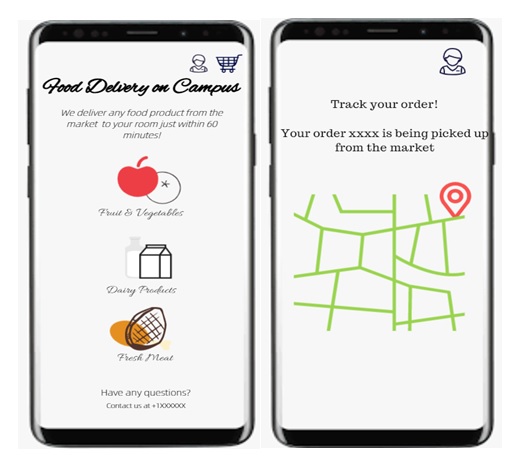The use of cell phone innovation can be viewed as one of the creative approaches to assist organizations in improving their business execution in the global market. The business exercises of an organization for all intents and purposes utilizing data innovation are known as e-commerce (Veronica, 2018). B2C internet business is currently the most widespread internet business model. Business to customer implies that the deal is occurring between a service or product provider and a buyer (Aggarwal & Aakash, 2018). This is the type of e-commerce suitable for my business, which is the delivery of food products to a college campus. With the presence of food conveyance applications, it is easy to provide customers with comfort while delivering the food items they need.
The service will be provided via a mobile app where a customer can order items from a known supermarket with a set price for food and the delivery fee will be shown on the interface. The information about the availability of the items at markets will be checked by our representatives in partner supermarkets. Each of them will update the data every morning and send it to the central system, where our people will change the information on the inventory on the app. The products on the menu may change because of the availability of food in the store at a given time, causing slight changes in real conveyance time.
In order to use our service, a potential client will need to join the system as a user and add the necessary data. This information will be fundamental, including payment card details to charge for the order. Clients will sign in to the app to submit a request and select the product they need. Whenever they chose all the needed items shown in the menu, the customers will finish the request by leaving a comment of the location they want to have it conveyed, and their request will be sent. A deliverer will be provided with the client’s order, chosen delivery place, and the location of the optimal supermarket for the conveyance. When the delivery is gathered from the market and received by the client, the order will be finished.
The image below represents a possible design of the mobile app for the consumers. It is planned to have a different section for each type of food product and a shopping cart where a user can see what he or she has chosen to purchase. The customer will also be able to see his or her profile and payment options at the upper right corner. In the profile, the customer can track the order with the help of the online map and check the status of the delivery. The app should also contain service help contacts in case of any issue during delivery. The design should be simple and clear to make navigation in the portal comfortable.

In conclusion, online trade makes shopping more straightforward, quicker, and less tedious, making 24-hour sales, easy refunds, and quick delivery available. Internet use in the culinary business has advanced the capacity of cell phones. The technological advancement of electronic trade has brought extraordinary changes in different enterprises, including the field of the culinary and delivery industries. Thus, the professional and easy-to-navigate platform can build consumer satisfaction, which expands client loyalty.
References
Aggarwal, A. G., & Aakash, N. (2018). Multi-criteria-based prioritisation of B2C e-commerce website. International Journal of Society Systems Science, 10(3), 201.
Veronica, V. (2018). E-Commerce feasibility analysis and strategic planning to develop a small-medium enterprise project in banking company. ComTech: Computer, Mathematics and Engineering Applications, 9(2), 59.